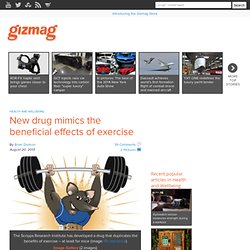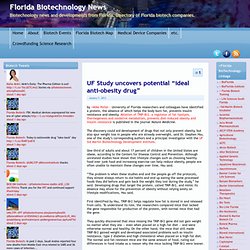

Aspirin as a promoter of ephedrine-induced th... [Am J Clin Nutr. 1987. Ephedrine, caffeine and aspiri... [Int J Obes Relat Metab Disord. 1993. Drug Candidate Leads to Improved Endurance. By Eric Sauter An international group of scientists has shown that a drug candidate designed by scientists from the Florida campus of The Scripps Research Institute (TSRI) significantly increases exercise endurance in animal models.

These findings could lead to new approaches to helping people with conditions that acutely limit exercise tolerance, such as obesity, chronic obstructive pulmonary disease (COPD) and congestive heart failure, as well as the decline of muscle capacity associated with aging. The study was published July 14, 2013, by the journal Nature Medicine. The drug candidate, SR9009, is one of a pair of compounds developed in the laboratory of TSRI Professor Thomas Burris and described in a March 2012 issue of the journal Nature as reducing obesity in animal models.
The compounds affect the core biological clock, which synchronizes the rhythm of the body’s activity with the 24-hour cycle of day and night. Send comments to: mikaono[at]scripps.edu. New drug mimics the beneficial effects of exercise. A drug known as SR9009, which is currently under development at The Scripps Research Institute (TSRI), increases the level of metabolic activity in skeletal muscles of mice.

Treated mice become lean, develop larger muscles and can run much longer distances simply by taking SR9009, which mimics the effects of aerobic exercise. If similar effects can be obtained in people, the reversal of obesity, metabolic syndrome, and perhaps Type-II diabetes might be the very welcome result. The drug was developed by Professor Thomas Burris, who found that it was able to reduce obesity in populations of mice. It binds to and activates a protein called Rev-ErbAα, which influences fat and sugar burning in the liver, production of fat cells, and the body's inflammatory response.
Drug candidate SR9009 is a simple molecule that produces significant benefits (Image: The Scripps Research Institute) “The animals actually get muscles like an athlete who has been training,” said Burris. Old drug may point the way to new treatments for diabetes and obesity. The obese mouse on the right was fed a high-fat diet.

The mouse on the left was fed the same diet but is a normal weight after receiving amlexanox. Image credit: Shannon Reilly.ANN ARBOR—Researchers at the University of Michigan's Life Sciences Institute have found that amlexanox, an off-patent drug currently prescribed for the treatment of asthma and other uses, also reverses obesity, diabetes and fatty liver in mice. The findings from the lab of Alan Saltiel, the Mary Sue Coleman director of the Life Sciences Institute, are scheduled to be published online Feb. 10 in the journal Nature Medicine. "One of the reasons that diets are so ineffective in producing weight loss for some people is that their bodies adjust to the reduced calories by also reducing their metabolism, so that they are 'defending' their body weight," Saltiel said.
"Amlexanox seems to tweak the metabolic response to excessive calorie storage in mice. " The drug has been on the market in Japan for more than 25 years. UF Study uncovers potential “ideal anti-obesity drug” « Florida Biotechnology News. By +Mike Poller – University of Florida researchers and colleagues have identified a protein, the absence of which helps the body burn fat, prevents insulin resistance and obesity.

Ablation of TRIP-Br2, a regulator of fat lipolysis, thermogenesis and oxidative metabolism, prevents diet-induced obesity and insulin resistance is published in the journal Nature Medicine. The discovery could aid development of drugs that not only prevent obesity, but also spur weight loss in people who are already overweight, said Dr. Stephen Hsu, one of the study’s corresponding authors and a principal investigator with the UF Sid Martin Biotechnology Development Institute. One-third of adults and about 17 percent of children in the United States are obese, according to the Centers for Disease Control and Prevention. First identified by Hsu, TRIP-Br2 helps regulate how fat is stored in and released from cells. When functioning normally, TRIP-Br2 restricts the amount of fat that cells burn as energy.